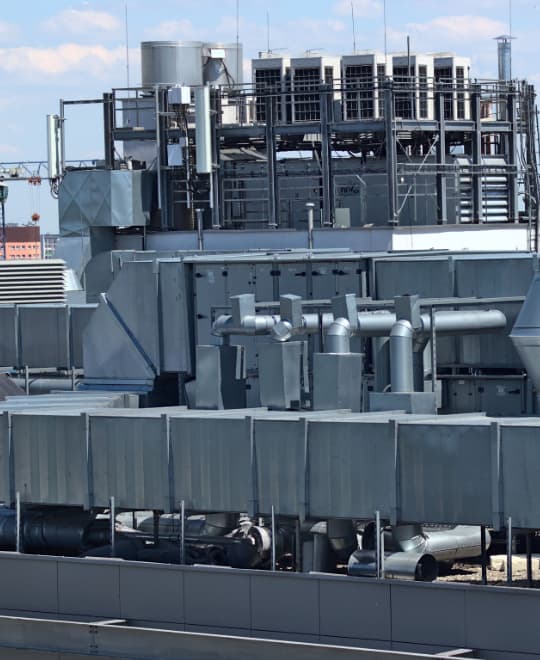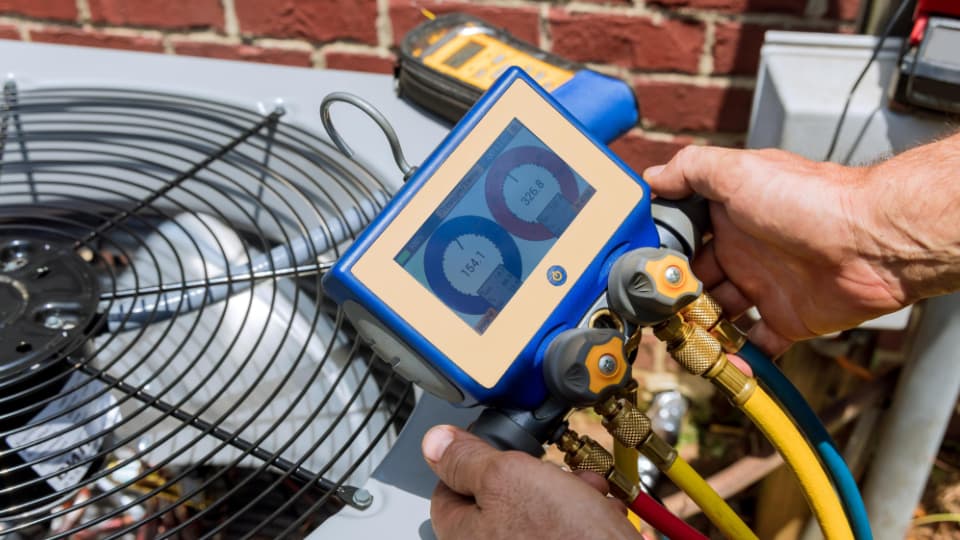HVAC
“Heating, Ventilation, and Air Conditioning.”
HVAC Services

What is HVAC?
HVAC stands for Heating, Ventilation, and Air Conditioning. It refers to the technology and systems used to control the indoor environment, ensuring comfort, air quality, and temperature regulation in residential, commercial, and industrial spaces.
Key Components of HVAC Systems:
- Heating:
- Provides warmth during colder months using systems like furnaces, boilers, or heat pumps.
- Ensures a comfortable indoor temperature in winter.
- Ventilation:
- Manages airflow to maintain indoor air quality by removing stale air, odors, and pollutants.
- Includes systems like fans, ducts, and air exchangers to circulate fresh air.
- Air Conditioning:
- Cools indoor spaces during warmer months using systems like central air conditioners, split units, or chillers.
- Regulates humidity levels for added comfort.
How HVAC Systems Work:
HVAC systems use a combination of components to heat, cool, and ventilate spaces. They typically include:
- Thermostats: Control the temperature by signaling the system to heat or cool as needed.
- Ductwork: Distributes conditioned air throughout the building.
- Air Handlers and Fans: Circulate air through the system.
- Filters: Remove dust, allergens, and pollutants from the air.
- Refrigerants: Used in air conditioning systems to absorb and release heat.

Importance of HVAC Systems:
- Comfort: Maintains a consistent and comfortable indoor temperature year-round.
- Air Quality: Improves indoor air quality by filtering and ventilating air.
- Energy Efficiency: Modern HVAC systems are designed to reduce energy consumption and lower utility bills.
- Health and Safety: Proper ventilation reduces the risk of mold, allergens, and harmful pollutants.
Applications of HVAC Systems:
- Residential: Homes, apartments, and villas.
- Commercial: Offices, malls, hotels, and restaurants.
- Industrial: Factories, warehouses, and manufacturing plants.
- Institutional: Schools, hospitals, and government buildings.
In summary, HVAC systems are essential for creating comfortable, healthy, and energy-efficient indoor environments. They play a critical role in modern living and working spaces, ensuring optimal temperature control and air quality.
How We Provide HVAC Services
At Nojoom Al Nakheel, we deliver comprehensive HVAC services through a structured and professional approach, ensuring quality, efficiency, and customer satisfaction. Here’s how we do it:
Assessment and Planning
Installation
Repairs
Testing and Commissioning
Customer Support
Ductwork Services
- Fabrication of GI Ducts
- Installation and Insulation
- Duct Fixing
- Air Outlet Installation
- Machine Connections
- VCD, FD, and Sound Attenuators
- Fan Installation
- Splitter Dampers with Accessories
- Access Door Fixing
Machine Unit Services:
- Installation of Indoor and Outdoor Units
- DX Machine Works (FCUs and CUs)
- Copper Piping
- Testing and Commissioning
Chilled Water Pipe Services:
- Chilled Water Pipe Installation
- Support Structures
- MI Threaded Fittings
- Butt Weld Fittings with Insulation
- Canvas Cloth Vapor Barrier, Including All Fittings, Accessories, and Valves
- Testing and Commissioning
Ductwork Services
Ductwork Services
Ductwork services are essential for the efficient operation of HVAC (Heating, Ventilation, and Air Conditioning) systems. These services include the fabrication, installation, insulation, and maintenance of ductwork, as well as the integration of components like air outlets, fans, and dampers. Below is a detailed breakdown of the key ductwork services:
Fabrication of GI Ducts
- Material Selection: Use high-quality galvanized iron (GI) sheets for durability and corrosion resistance.
- Cutting and Shaping: Precision cutting and bending of sheets to create rectangular, round, or oval ducts.
- Flanging and Sealing: Forming flanges for joint connections and sealing edges to ensure airtightness.
- Reinforcement: Adding stiffeners or supports for larger ducts to maintain structural integrity.
Installation and Insulation
- Installation:
- Positioning and securing ducts according to the design layout.
- Connecting ducts to HVAC equipment and air outlets.
- Ensuring proper sealing of joints to prevent air leaks.
- Insulation:
- Wrapping ducts with insulation materials (e.g., fiberglass, foam) to reduce heat loss/gain and prevent condensation.
- Improving energy efficiency and noise reduction.
Duct Fixing
- Support Systems: Installing hangers, brackets, and supports to secure ducts in place.
- Alignment: Ensuring ducts are properly aligned and level for optimal airflow.
- Repair Services: Fixing leaks, dents, or disconnected sections of ductwork.
Air Outlet Installation
- Types of Outlets: Installing diffusers, grilles, registers, and louvers for air supply and return.
- Placement: Positioning outlets for even air distribution and aesthetic integration.
- Balancing: Adjusting dampers to achieve proper airflow and comfort levels.
Machine Connections
- HVAC Equipment: Connecting ducts to air handlers, fan coil units (FCUs), chillers, and other equipment.
- Refrigerant Lines: Integrating copper piping for refrigerant flow in DX systems.
- Electrical Connections: Ensuring proper wiring for fans, dampers, and controls.
VCD, FD, and Sound Attenuators
- Volume Control Dampers (VCDs): Installing dampers to regulate airflow in different zones.
- Fire Dampers (FDs): Integrating fire-rated dampers to prevent the spread of fire through ductwork.
- Sound Attenuators: Adding acoustic insulation or silencers to reduce noise from airflow and equipment.
Fan Installation
- Types of Fans: Installing axial, centrifugal, or inline fans for air movement.
- Placement: Positioning fans in ducts or equipment rooms for optimal performance.
- Balancing: Adjusting fan speed and airflow to meet system requirements.
Splitter Dampers with Accessories
- Function: Installing splitter dampers to divide or control airflow in branch ducts.
- Accessories: Adding actuators, linkages, and controls for automated operation.
- Balancing: Ensuring even airflow distribution across all branches.
Access Door Fixing
- Purpose: Installing access doors for inspection, cleaning, and maintenance of ductwork.
- Placement: Positioning doors at strategic locations for easy access to critical components.
- Sealing: Ensuring doors are airtight to prevent leaks.
Benefits of Professional Ductwork Services
- Energy Efficiency: Properly designed and installed ductwork reduces energy consumption.
- Improved Air Quality: Clean and well-sealed ducts prevent contaminants from entering the air supply.
- Noise Reduction: Insulation and sound attenuators minimize noise from airflow and equipment.
- System Longevity: Regular maintenance and repairs extend the life of the HVAC system.
- Cost Savings: Efficient ductwork reduces operational costs and prevents costly breakdowns.
Applications of Ductwork Services
- Residential: Homes, apartments, and villas.
- Commercial: Offices, retail stores, and restaurants.
- Industrial: Factories, warehouses, and production facilities.
- Institutional: Schools, hospitals, and government buildings.
- Specialized Environments: Cleanrooms, laboratories, and data centers.
Professional ductwork services ensure the efficient, reliable, and safe operation of HVAC systems. From fabrication and installation to maintenance and repair, these services are essential for maintaining indoor comfort, energy efficiency, and air quality.
Machine Unit Services
Machine Unit Services
Machine unit services encompass the installation, maintenance, and optimization of HVAC (Heating, Ventilation, and Air Conditioning) equipment, including indoor and outdoor units, DX (Direct Expansion) systems, and associated components like copper piping. These services ensure efficient operation, energy savings, and long-term reliability of HVAC systems. Below is a detailed overview of the key services:
Installation of Indoor and Outdoor Units
- Indoor Units:
- Includes air handlers, fan coil units (FCUs), and evaporator coils.
- Installed in designated areas such as ceilings, walls, or utility closets.
- Proper placement ensures even air distribution and easy access for maintenance.
- Outdoor Units:
- Includes condensers, heat pumps, and compressor units.
- Installed in well-ventilated areas with adequate clearance for airflow and maintenance.
- Mounted on stable platforms or pads to reduce vibration and noise.
- Electrical and Refrigerant Connections:
- Connect indoor and outdoor units with refrigerant lines and electrical wiring.
- Ensure proper sizing and insulation of refrigerant lines to prevent energy loss.
DX Machine Works (FCUs and CUs)
- Fan Coil Units (FCUs):
- Installed in individual rooms or zones to provide localized heating and cooling.
- Connected to a central chiller or boiler for water-based systems.
- Regular maintenance includes cleaning filters, coils, and drain pans.
- Condensing Units (CUs):
- Part of the outdoor unit, responsible for heat exchange and refrigerant compression.
- Requires proper sizing and placement for optimal performance.
- Maintenance includes cleaning condenser coils, checking refrigerant levels, and inspecting electrical components.
Copper Piping
- Installation:
- Copper pipes are used to connect indoor and outdoor units for refrigerant flow.
- Proper sizing and routing of pipes ensure efficient refrigerant circulation.
- Insulate pipes to prevent condensation and energy loss.
- Brazing and Jointing:
- Use high-quality brazing techniques to create leak-free joints.
- Ensure joints are clean and free from contaminants to prevent system failures.
- Pressure Testing:
- Test copper piping for leaks and durability before system commissioning.
Testing and Commissioning
- System Testing:
- Check for refrigerant leaks, proper airflow, and electrical connections.
- Test controls, thermostats, and safety devices for functionality.
- Performance Verification:
- Measure system capacity, efficiency, and temperature control.
- Ensure the system meets design specifications and load requirements.
- Balancing:
- Adjust dampers, fan speeds, and refrigerant flow to achieve optimal performance.
- Documentation:
- Provide detailed reports on system performance, test results, and commissioning data.
- Client Training:
- Educate clients on system operation, maintenance, and troubleshooting.
Benefits of Professional Machine Unit Services
- Efficient Installation: Proper setup ensures optimal performance and energy efficiency.
- Reliable Operation: Regular maintenance and testing prevent breakdowns and extend equipment life.
- Energy Savings: Well-installed and maintained systems reduce energy consumption and utility costs.
- Improved Comfort: Properly balanced systems provide consistent heating and cooling.
- Safety: Ensures compliance with safety standards and reduces risks of leaks or electrical faults.
When to Seek Machine Unit Services
- During new HVAC system installation or replacement.
- When upgrading or expanding existing systems.
- If experiencing uneven heating or cooling.
- For routine maintenance to prevent system failures.
- When noticing refrigerant leaks, unusual noises, or reduced efficiency.
Professional machine unit services are essential for ensuring the efficient, reliable, and safe operation of HVAC systems. Whether for residential, commercial, or industrial applications, these services play a crucial role in maintaining indoor comfort and energy efficiency.

Chilled Water Pipe Services
Chilled Water Pipe Services
Chilled water pipe systems are a critical component of HVAC (Heating, Ventilation, and Air Conditioning) systems, particularly in large commercial, industrial, and institutional buildings. These systems circulate chilled water to air handlers and fan coil units (FCUs) for cooling purposes. Proper installation, insulation, and maintenance of chilled water pipes are essential for efficient operation and energy savings. Below is a detailed overview of the key services:
Chilled Water Pipe Installation
- Material Selection: Use high-quality materials such as carbon steel, copper, or PEX (cross-linked polyethylene) based on system requirements.
- Pipe Sizing: Ensure proper sizing of pipes to handle the required flow rate and pressure.
- Routing and Layout: Plan and install pipes to minimize bends and ensure efficient water flow.
- Jointing Methods: Use appropriate techniques such as threading, welding, or flanging for secure connections.
Support Structures
- Hangers and Brackets: Install sturdy supports to hold pipes in place and prevent sagging or vibration.
- Vibration Isolation: Use rubber pads or isolators to reduce noise and vibration transmission.
Spacing: Follow industry standards for support spacing based on pipe size and material.
MI Threaded Fittings
- Threaded Connections: Install threaded fittings for easy assembly and disassembly of pipes.
- Leak Prevention: Use thread sealants or tapes to ensure airtight and watertight connections.
- Compatibility: Ensure fittings are compatible with the pipe material and system pressure.
Butt Weld Fittings with Insulation
- Welding Process: Use butt welding for strong, durable connections in steel or stainless steel pipes.
- Quality Control: Inspect welds for defects and ensure proper alignment.
- Insulation: Wrap welded joints with insulation materials (e.g., fiberglass or foam) to prevent heat gain and condensation.
Canvas Cloth Vapor Barrier, Including All Fittings, Accessories, and Valves
- Vapor Barrier Installation: Wrap pipes with canvas cloth or other vapor barrier materials to prevent moisture ingress.
- Fittings and Accessories: Ensure all fittings, valves, and accessories are properly insulated and sealed.
- Sealing: Use adhesives or tapes to secure the vapor barrier and maintain its integrity.
Testing and Commissioning
- Pressure Testing: Test the system for leaks and durability by pressurizing it with water or air.
- Flow Testing: Verify that the system delivers the required flow rate to all components.
- Balancing: Adjust valves and controls to ensure even distribution of chilled water.
- Documentation: Provide detailed reports on system performance, test results, and commissioning data.
- Client Training: Educate clients on system operation, maintenance, and troubleshooting.
Benefits of Professional Chilled Water Pipe Services
- Energy Efficiency: Properly installed and insulated pipes reduce energy loss and improve system performance.
- Durability: High-quality materials and installation techniques ensure long-lasting performance.
- Leak Prevention: Thorough testing and sealing prevent water leaks and system downtime.
- Noise Reduction: Proper support and insulation minimize noise and vibration.
- Cost Savings: Efficient systems reduce operational costs and prevent costly repairs.
Applications of Chilled Water Pipe Systems
- Commercial Buildings: Offices, malls, and hotels.
- Industrial Facilities: Factories, warehouses, and production plants.
- Institutional Buildings: Schools, hospitals, and government facilities.
- Data Centers: Cooling for high-density server rooms.
Professional chilled water pipe services ensure the efficient, reliable, and safe operation of HVAC systems. From installation and insulation to testing and commissioning, these services are essential for maintaining optimal performance and energy efficiency.

